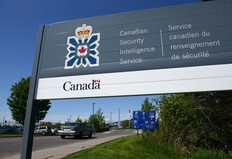One dead in second London outbreak of legionnaires' disease in two years
One person has died in the second outbreak of legionnaires' disease in London in two years, the Middlesex-London Health Unit says

Article content
Public health officials have declared a Legionnaires’ disease outbreak in southeast London, with 43 confirmed cases in 2025 – including 35 in the past week – and one person dead.
It’s the second outbreak of the rare respiratory disease in London in two years.
Recommended Videos
Most cases involve people who live or work within a six-kilometre radius in the city’s southeast, the Middlesex-London Health Unit said in a statement Tuesday.
Joanne Kearon, the health unit’s associate medical officer of health, said the outbreak area overlaps with the zone investigated during last summer’s outbreak. She added that the sharp rise in recent cases suggests a larger environmental source.
She confirmed most people diagnosed with Legionnaires’ disease in this outbreak have required hospitalization. “That’s typically where the diagnosis would happen,” Kearon said.
Milder cases, known as Pontiac fever, often go undiagnosed because there’s no reason to test for legionella unless symptoms are severe, she said.
Legionnaires’ disease is a severe respiratory illness caused by legionella bacteria commonly found in water systems such as cooling towers, hot tubs, hot water tanks and large plumbing systems. People can become infected by breathing in tiny droplets of contaminated water that have been aerosolized by wind or fans. The illness is not spread through person-to-person contact.
Symptoms usually appear two to 10 days after exposure and can include high fever, chills, dry cough and shortness of breath. The infection can lead to pneumonia and, in severe cases, be life-threatening.
Older adults, people with lung conditions and those who are immunocompromised are at higher risk.
Kearon said those who have Legionnaires’ disease tend to have underlying comorbidities and “very often, are smokers.”
The health unit said it’s working with Public Health Ontario and its laboratories to test multiple sites across southeast London, but no confirmed source has been identified. “Since legionella can be dispersed and spread with the wind, it can travel quite the distance,” Kearon said, noting the investigation area is large.
“I know people are anxious to understand the location and, unfortunately, we do not have a location at this point,” she said. “If we did, we would share that and also remediate that so there would be no ongoing risk.”
Because legionella is common in the environment, the health unit is conducting subtyping to see if any detected bacteria match the strain causing illness. “It’s not unexpected that we will find legionella in the environment,” Kearon said.
The outbreak “has increased very rapidly” this year, she said, likely in part due to recent weather conditions. “It’s been hot and humid and legionella loves that environment. It can stay in the air longer.”
A Legionnaires’ disease outbreak in London last July led to 30 confirmed cases, two deaths and nine patients admitted to intensive care before it was declared over in October. Despite testing 18 cooling tower sites, the health unit never identified a confirmed source of the outbreak. Investigators focused on a five- to 10-kilometre radius in southeast London, but did not specify where.
Kearon confirmed this year’s outbreak is in the same area. She said it remains unclear whether this year’s cases are caused by the same strain, as clinical samples necessary to make that determination have not yet been analyzed.
The health unit has expanded its investigation zone and is “considering other potential sources,” she said.
If a source is found, Kearon said, the MLHU will require the operator to sanitize the system and conduct follow-up testing to ensure the bacteria is eliminated.
Kearon is advising building owners and property managers in the southeast to ensure cooling equipment is properly maintained and sanitized according to the manufacturer’s instructions. Anyone experiencing symptoms is encouraged to seek medical care











Postmedia is committed to maintaining a lively but civil forum for discussion. Please keep comments relevant and respectful. Comments may take up to an hour to appear on the site. You will receive an email if there is a reply to your comment, an update to a thread you follow or if a user you follow comments. Visit our Community Guidelines for more information.